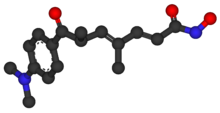Trichostatin A
 | |
 | |
| Clinical data | |
|---|---|
| Pregnancy category | |
| ATC code |
|
| Identifiers | |
| |
| CAS Number | |
| PubChem CID | |
| DrugBank | |
| ChemSpider | |
| ChEBI | |
| ChEMBL | |
| CompTox Dashboard (EPA) | |
| ECHA InfoCard | 100.107.856 |
| Chemical and physical data | |
| Formula | C17H22N2O3 |
| Molar mass | 302.37 g/mol g·mol−1 |
| 3D model (JSmol) | |
| |
| |
| | |
Trichostatin A (TSA) is an organic compound that serves as an antifungal antibiotic and selectively inhibits the class I and II mammalian histone deacetylase (HDAC) families of enzymes, but not class III HDACs (i.e., Sirtuins).[1] TSA inhibits the eukaryotic cell cycle during the beginning of the growth stage. TSA can be used to alter gene expression by interfering with the removal of acetyl groups from histones (histone deacetylases, HDAC) and therefore altering the ability of DNA transcription factors to access the DNA molecules inside chromatin. It is a member of a larger class of histone deacetylase inhibitors (HDIs or HDACIs) that have a broad spectrum of epigenetic activities. Thus, TSA has some potential as an anti-cancer drug.[2] One suggested mechanism is that TSA promotes the expression of apoptosis-related genes, leading to cancerous cells surviving at lower rates, thus slowing the progression of cancer.[3] Other mechanisms may include the activity of HDIs to induce cell differentiation, thus acting to "mature" some of the de-differentiated cells found in tumors. HDIs have multiple effects on non-histone effector molecules, so the anti-cancer mechanisms are truly not understood at this time.
TSA inhibits HDACs 1, 3, 4, 6 and 10 with IC50 values around 20 nM.[4]
TSA represses IL (interleukin)-1β/LPS (lipopolysaccharide)/IFNγ (interferon γ)-induced nitric oxide synthase (NOS)2 expression in murine macrophage-like cells but increases LPS-stimulated NOS2 expression in murine N9 and primary rat microglial cells.[5]
TSA has not been tested in clinical trials as of 2013-05-27.[6]
See also
- Histone deacetylase inhibitor
- Vorinostat (SAHA)
- Moon C, Kim SH (June 2009). "Use of epigenetic modification to induce FOXP3 expression in naïve T cells". Transplant Proc. 41 (5): 1848–54. doi:10.1016/j.transproceed.2009.02.101. PMID 19545742.
References
- ^ Vanhaecke T, Papeleu P, Elaut G, Rogiers V (2004). "Trichostatin A-like hydroxamate histone deacetylase inhibitors as therapeutic agents: toxicological point of view". Curr Med Chem. 11 (12): 1629–43. doi:10.2174/0929867043365099. PMID 15180568.
{{cite journal}}: CS1 maint: multiple names: authors list (link) - ^ Drummond DC, Noble CO, Kirpotin DB, Guo Z, Scott GK, Benz CC (2005). "Clinical development of histone deacetylase inhibitors as anticancer agents". Annu Rev Pharmacol Toxicol. 45: 495–528. doi:10.1146/annurev.pharmtox.45.120403.095825. PMID 15822187.
{{cite journal}}: CS1 maint: multiple names: authors list (link) - ^ Shankar S, Srivastava RK (2008). "Histone deacetylase inhibitors: mechanisms and clinical significance in cancer: HDAC inhibitor-induced apoptosis". Adv Exp Med Biol. Advances in Experimental Medicine and Biology. 615: 261–98. doi:10.1007/978-1-4020-6554-5_13. ISBN 978-1-4020-6553-8. PMID 18437899.
- ^ http://www.freepatentsonline.com/y2009/0263353.html
- ^ Adcock (2007). "HDAC inhibitors as anti-inflammatory agents".
- ^ http://clinicaltrials.gov/ct2/results?term=Trichostatin+A
